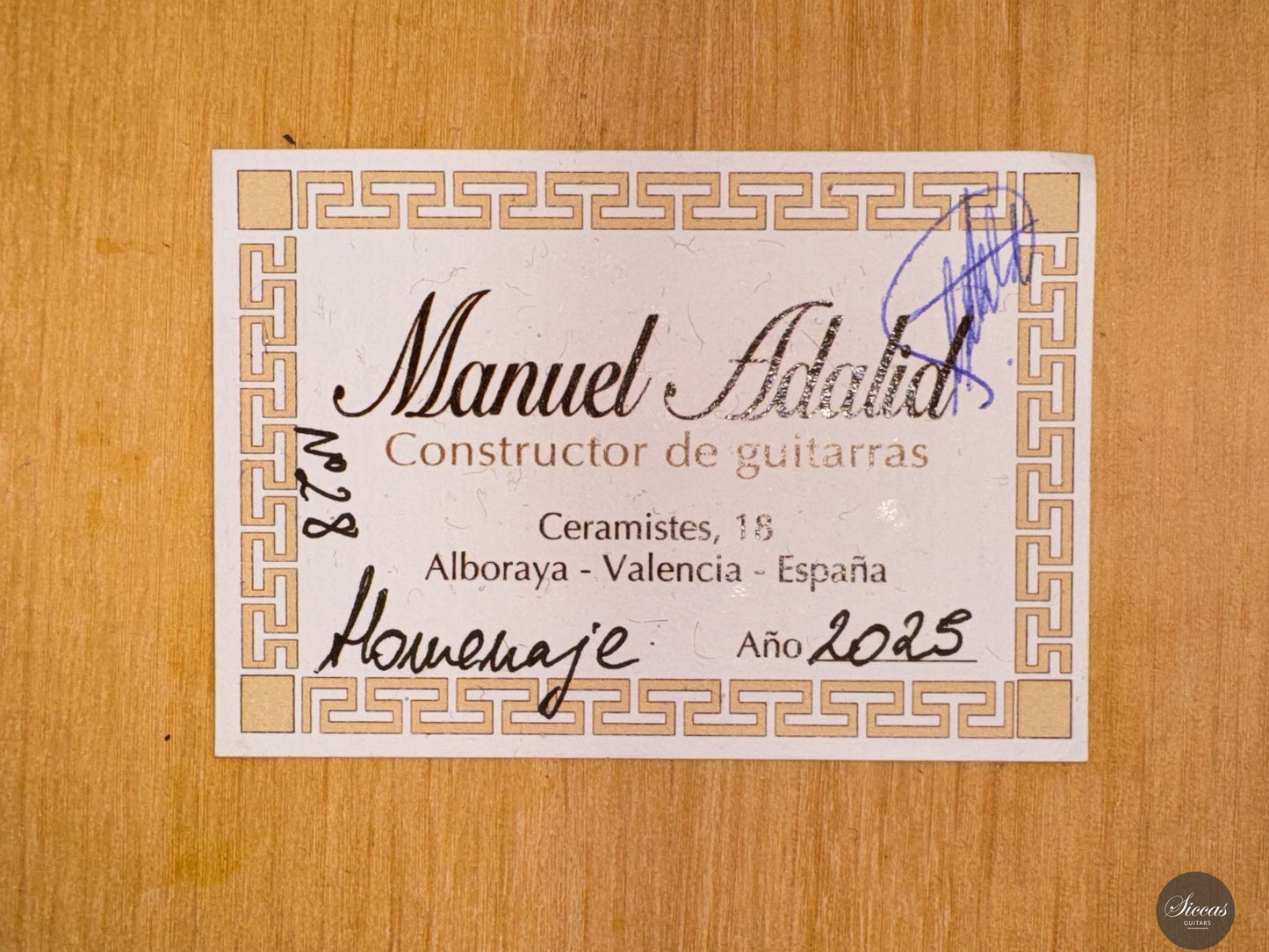Manuel Adalid - 2025 - Homenaje No. 28
Manuel Adalid - 2025 - Homenaje No. 28
Details
Details
Overview
Overview
Shipping important note
Shipping important note
Delivery times are typically reliable and most instruments arrive within the estimated timeframe.
Should any unexpected delay occur, our team will keep you informed and provide support at every step. For all shipping details and exceptions, please see our Shipping Policy.
Details about GPSR
Details about GPSR

























Video overview


More details about the guitar
About the luthier
Manuel Adalid, born in 1951, is one of Spain’s most accomplished contemporary luthiers. Raised in a family of guitar makers, he learned his craft from his father, Manuel Adalid Lázaro, as well as esteemed luthiers Francisco Esteve Calatayud and Antonio Monfort. Following business studies at the University of Valencia, he established a guitar trading company at age 18 and quickly became a leading client of Francisco Esteve Guitars. During this period, he also worked summers as an apprentice at the Esteve workshop, laying the groundwork for his technical formation. At 23, he fully committed to guitar making and returned to Guitarras Francisco Esteve, where he completed his apprenticeship under the guidance of his mentors. In 1980, he was appointed manager of the company, overseeing its expansion in both infrastructure and personnel. Under his direction, Esteve’s workshop tripled in size and gained international prestige. Beyond his managerial role, Adalid has contributed to the advancement of Spanish guitar making through international lectures and continuous research into modern construction techniques. Recognized as a Master Craftsman by the Generalitat Valenciana and currently serving as President of the Spanish Musical Instruments Association (AFIMA), he remains dedicated to refining his art and exploring new technologies in guitar building.About the guitar
The Manuel Adalid – 2025 Homenaje No. 28 exemplifies Adalid’s refined approach to modern classical guitar construction. This double-top model features a spruce soundboard paired with Ziricote back and sides, internally reinforced with cypress to enhance both projection and structural integrity. Designed for the concert stage, the guitar projects with notable volume and presence, making it ideal for both solo and ensemble settings. Its nitrocellulose finish provides durability and preserves the tonal qualities of the wood over time. Acoustically, the Homenaje No. 28 delivers impressive clarity and balance. The trebles are thick and well-defined, sustaining clearly above the full, dark basses. This coherence across registers makes it a versatile instrument capable of delivering both power and nuance. Whether used by a professional concert artist or a dedicated student, this guitar offers a responsive and satisfying playing experience that supports refined musical interpretation.Regular care extends the life of the instrument
Even with careful use, a classical guitar may gradually change in appearance or respond to unstable storage conditions. Have a close look at your guitar regularly and be attentif to changes. If your instrument is suffering from its environement, it will let you know.
Protect Your Guitar: Handle with Care
Be mindful when touching your instrument with greasy or unwashed hands: any skin contact is a small attack on the varnish. Of course, a guitar is made to be played, but taking a few precautions helps preserve its beauty: wash your hands before playing, wear long sleeves, and avoid unnecessary direct skin contact with the body of the instrument.
Pro tip: Avoid playing with a button-up shirt, heavy jewelry, or a belt, as these can scratch the guitar. Also, make sure your guitar case is free of any objects that could damage the instrument during storage.
String care
A good habit to adopt is wiping down your strings briefly after each playing session. This small action significantly extends their lifespan and helps maintain a consistent, comfortable feel under your fingers.
Most importantly, clean strings are essential for keeping your instrument in tune. Corrosion, sweat, and dust can affect the uniformity of the strings and interfere with accurate tuning across the entire fingerboard.
Pro tip: If you're having trouble getting your guitar in tune, it might be time to change the strings. A useful test is to compare the pitch of the 12th fret harmonic with the fretted note at the 12th fret; if there's an unusually large gap between them, your strings may have lost their integrity and should be replaced.
Keep Your Shellac Finish Shining!
Got a guitar with a shellac (French polish) finish? Here's a simple trick: Take a clean microfiber cloth and gently breathe on the surface to create a light mist. Then, softly rub to remove fingerprints, sweat, and grease. That’s usually all it takes to keep it looking great, no products needed!
Pro tip: Every few years, treat your guitar to a check-up with a luthier to keep it in top shape.
Storing Your Guitar: Climate Matters
Your guitar can safely stay outside its case, as long as the surrounding environment maintains 42–55% humidity and a temperature between 18–25°C.
Keep in mind that humidity levels can still fluctuate inside the case, especially during seasonal changes.
- Too much humidity may cause overtightened strings and a dull tone.
- Too little humidity can lead to a bulging top, string buzz, or even cracks.
Avoid placing your guitar near radiators, air conditioners, or windows with direct sunlight.
Pro tip: Always close your guitar case while playing. This helps preserve a stable microclimate inside the case, so your instrument is protected the moment you put it back in.





















































